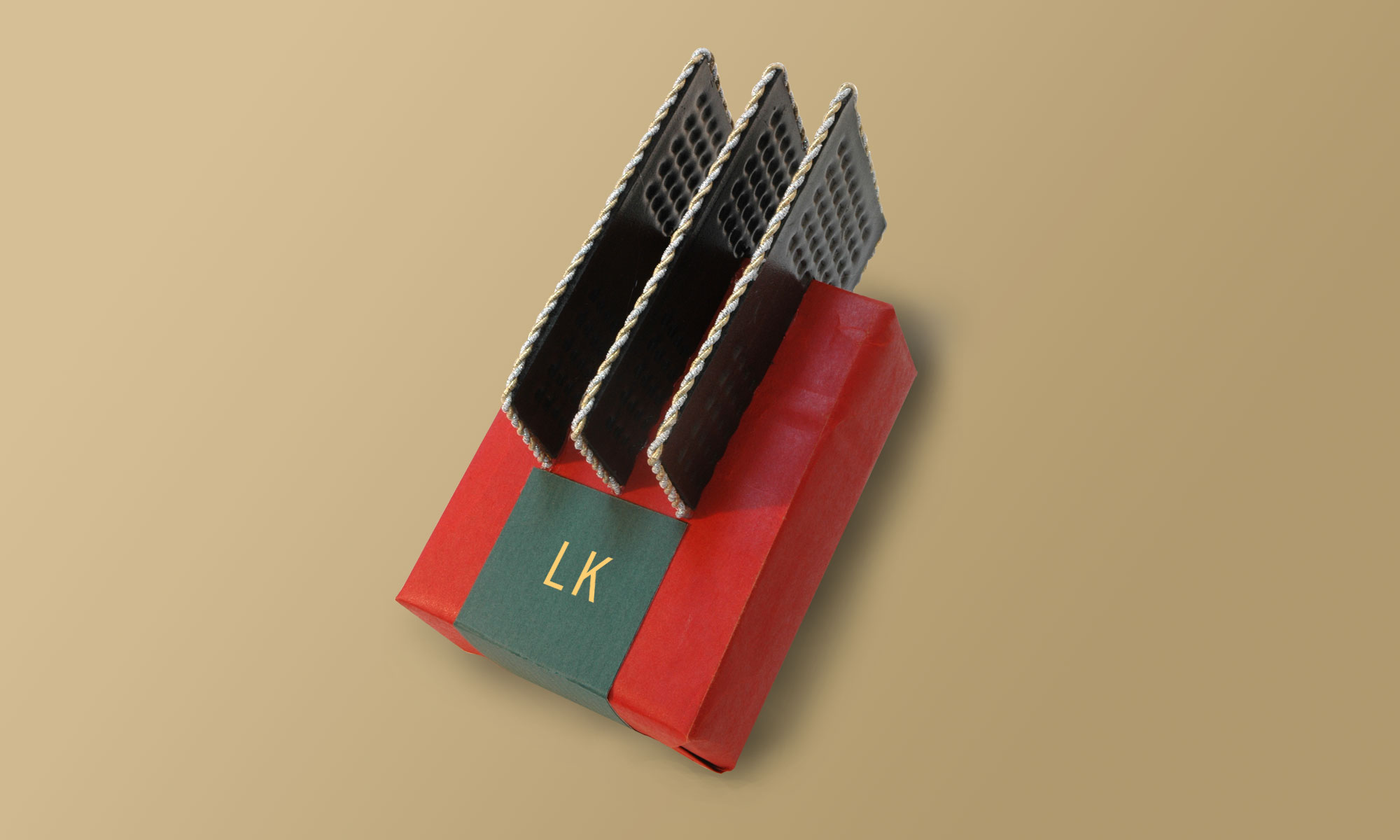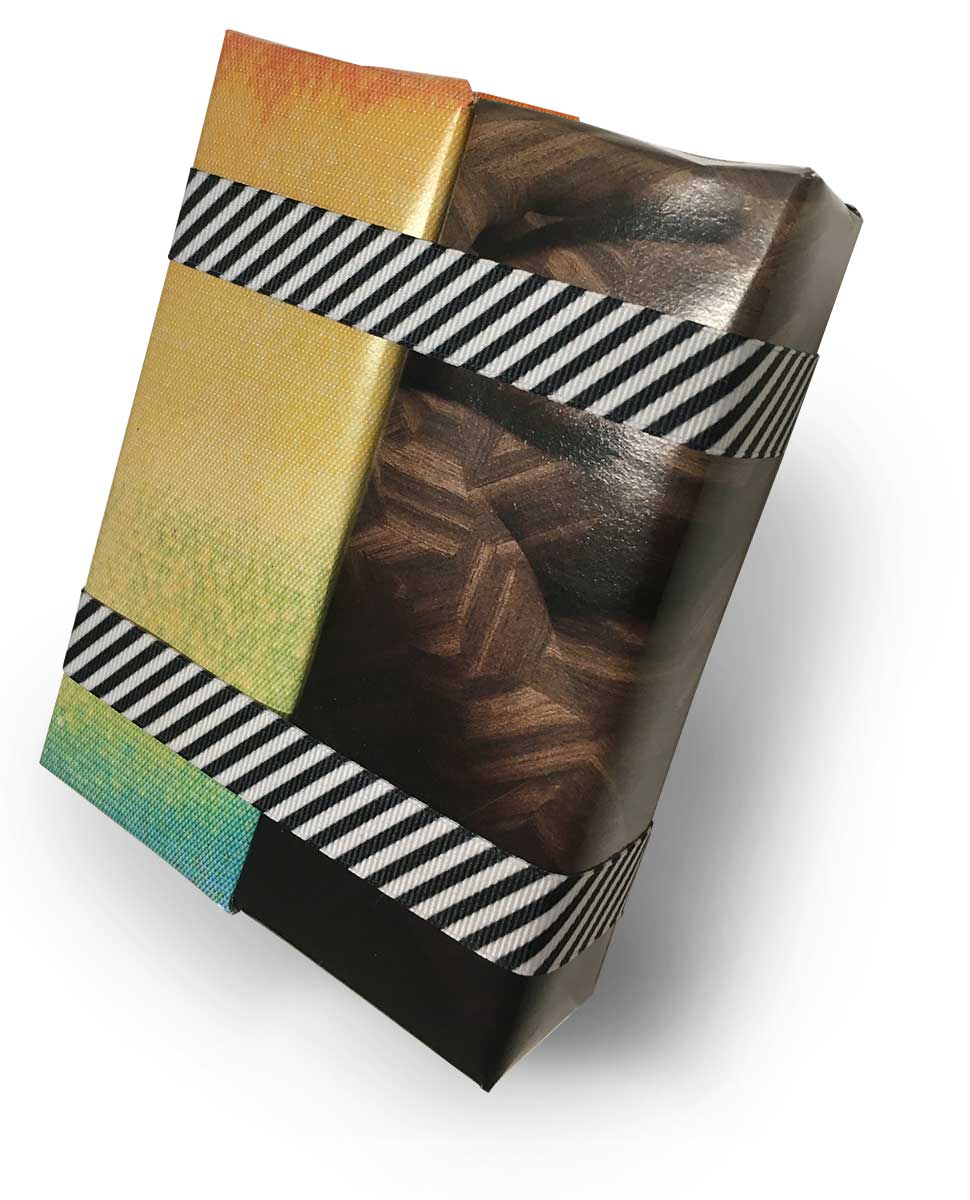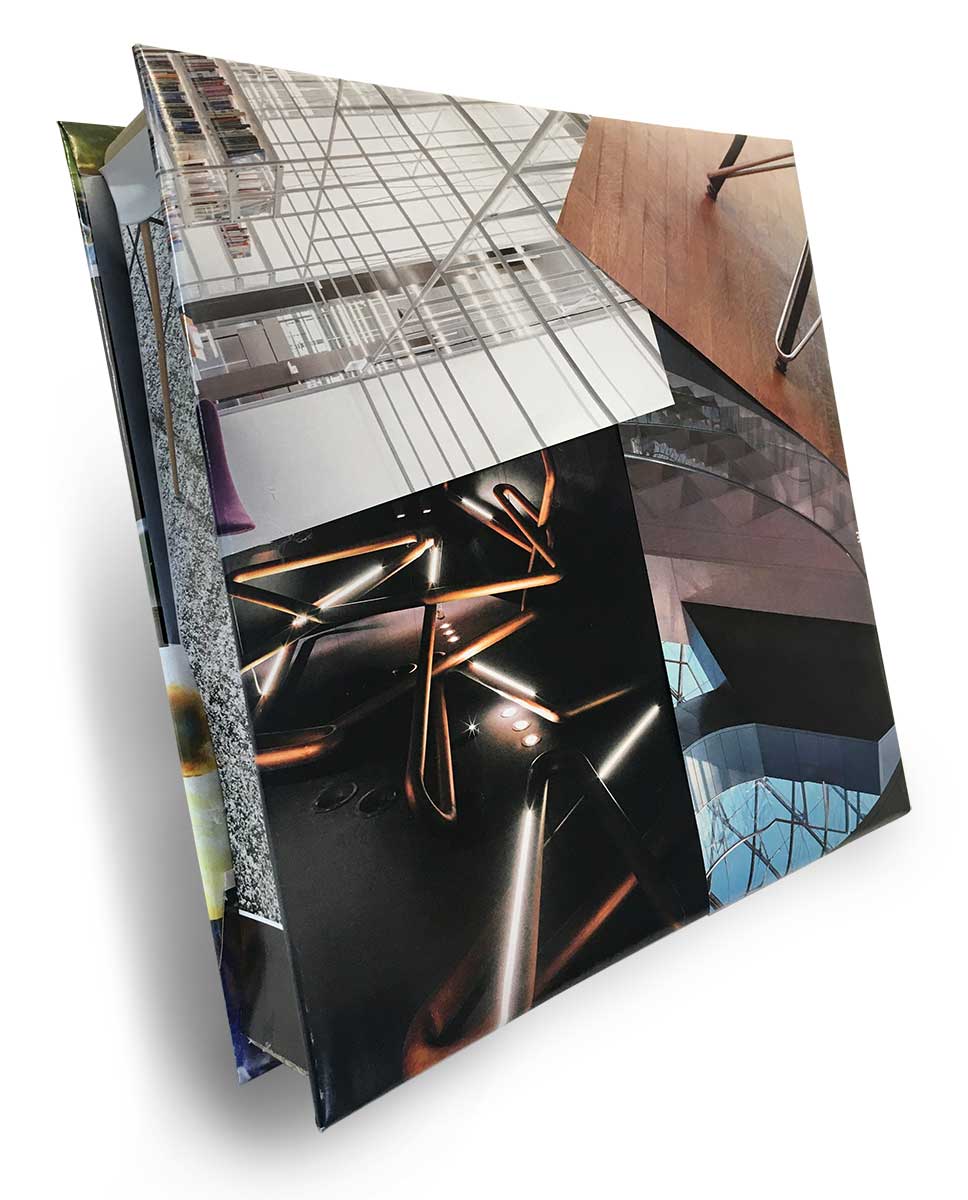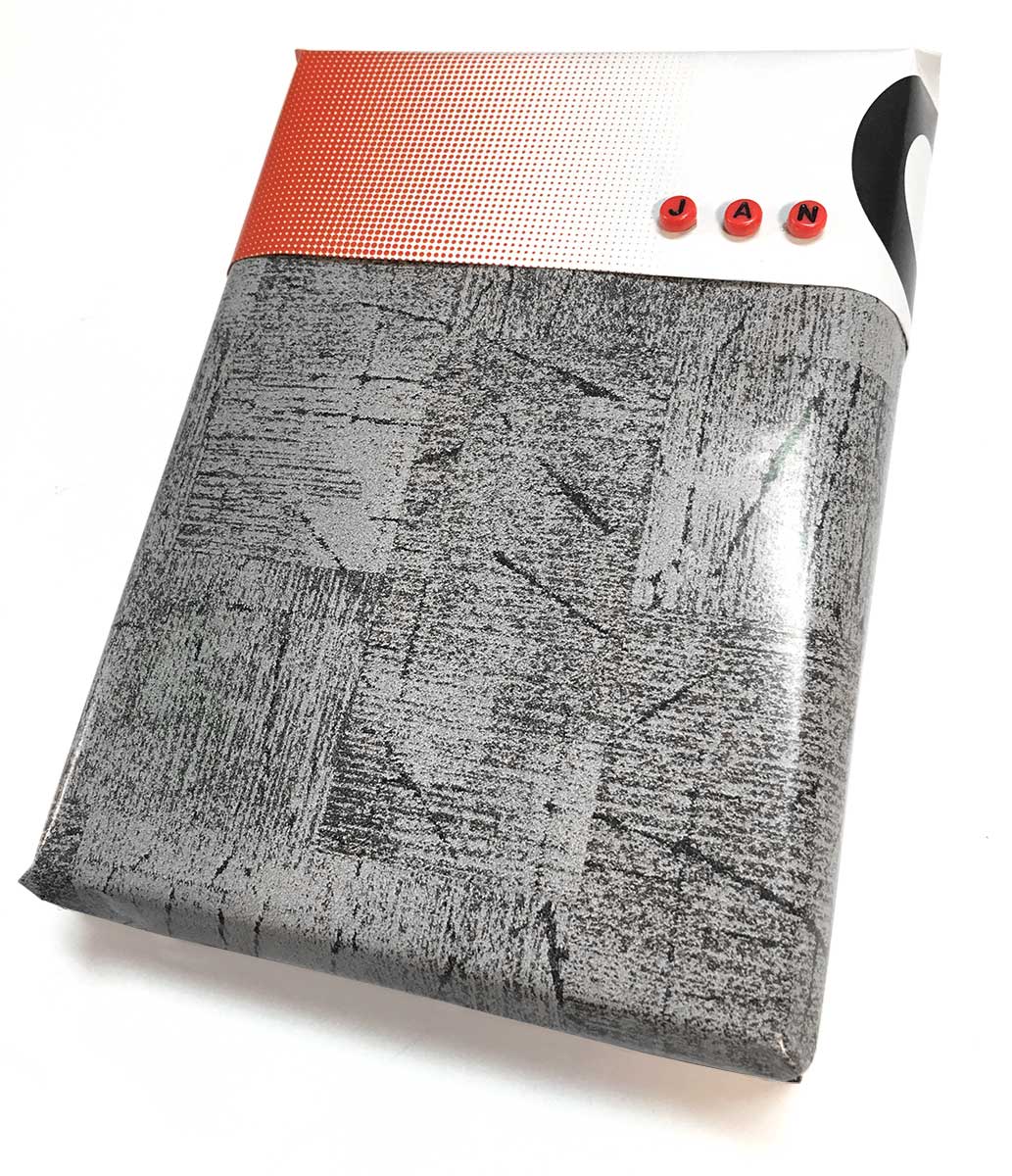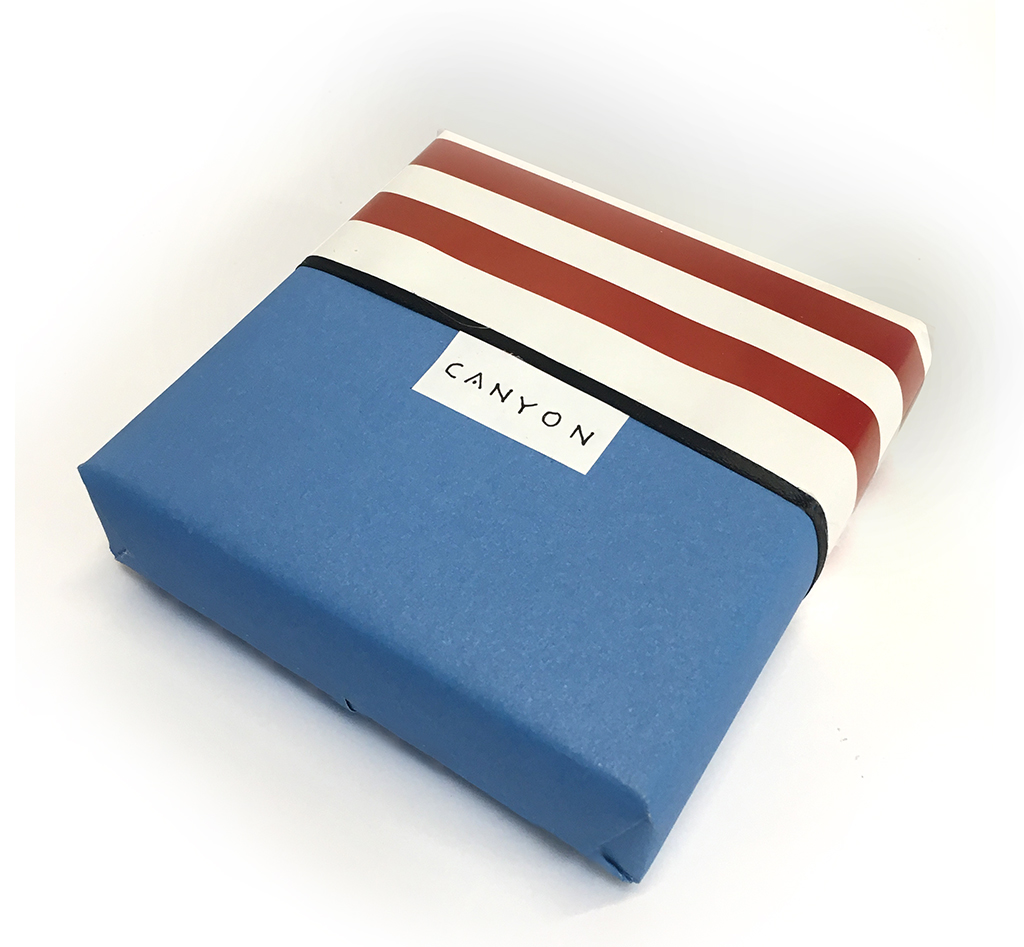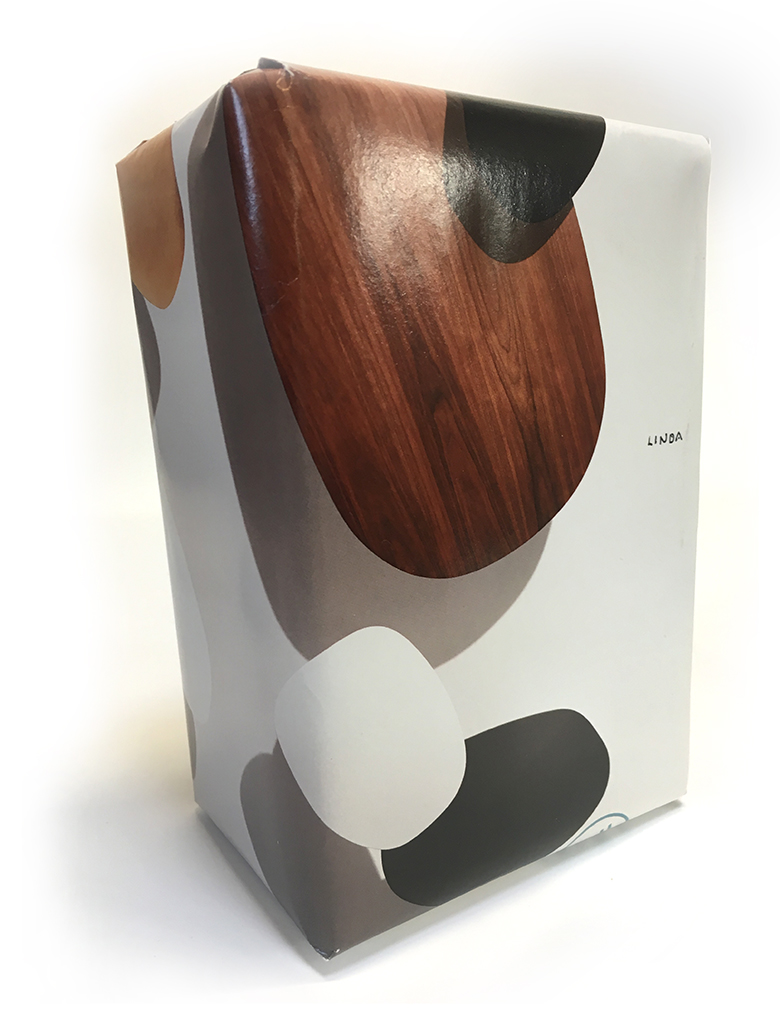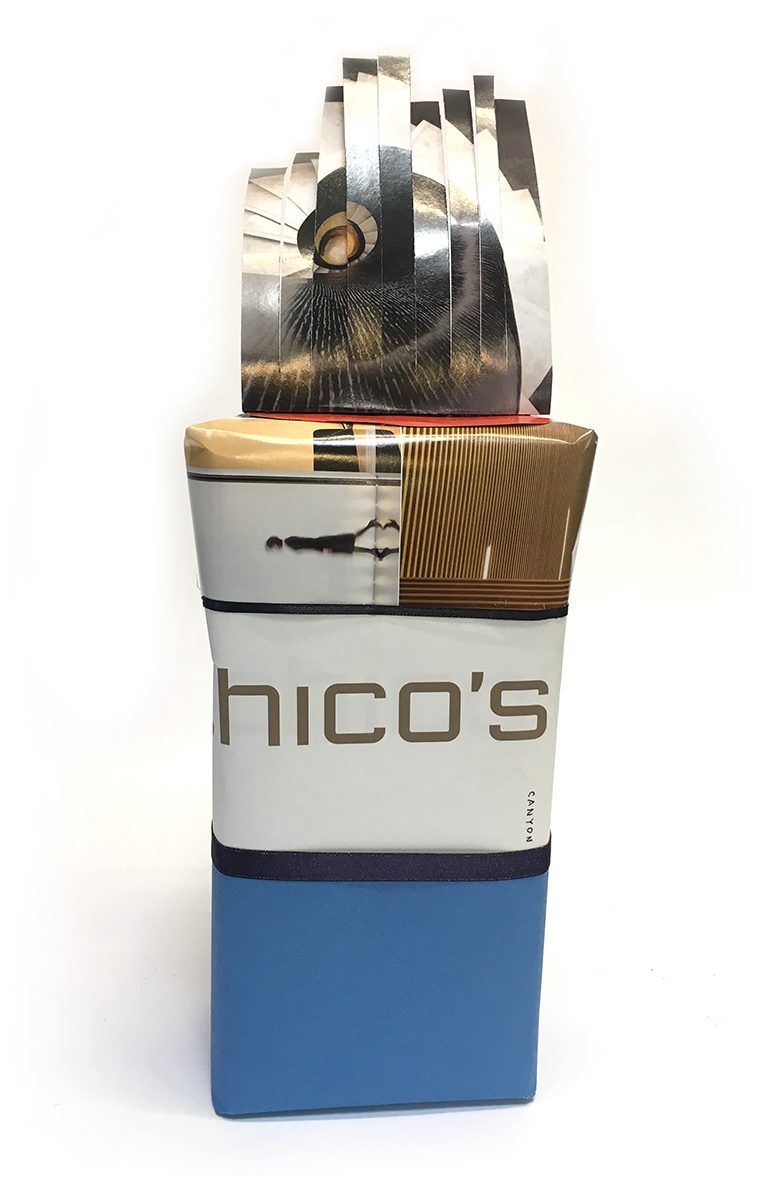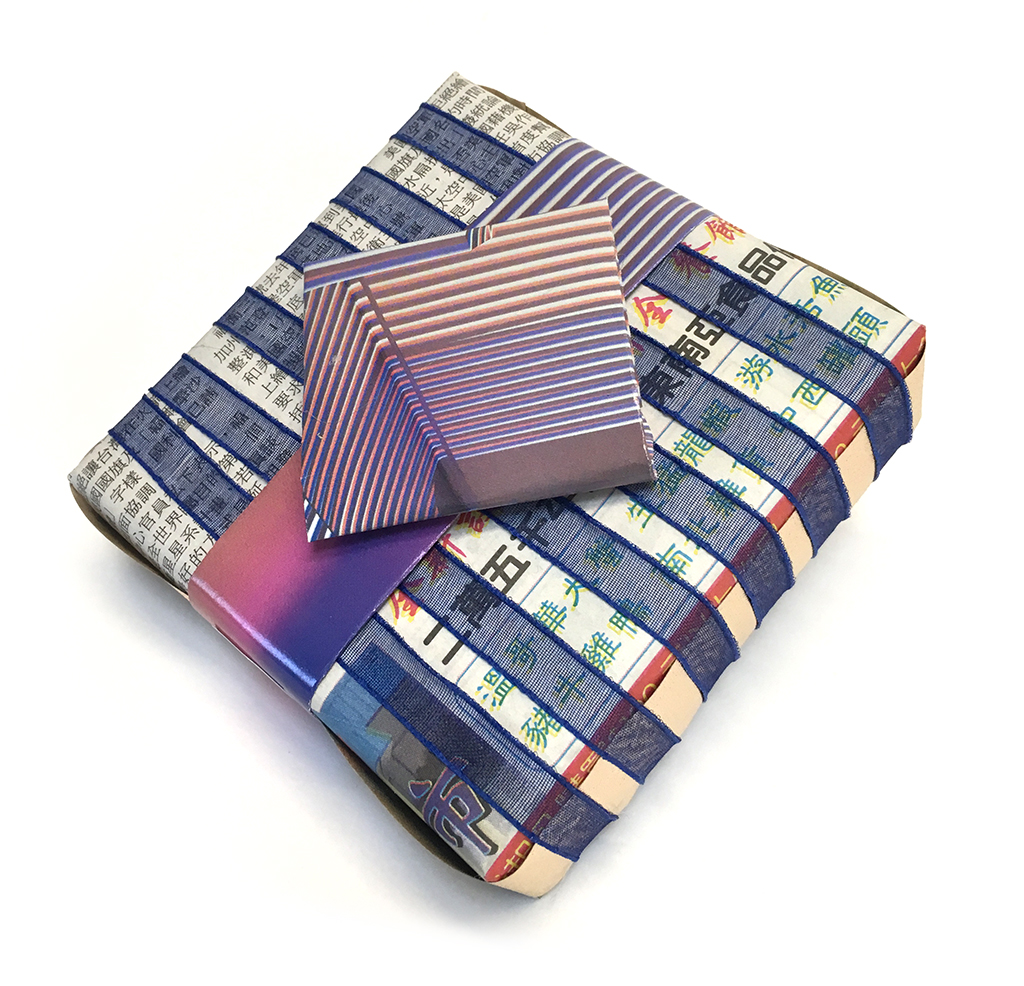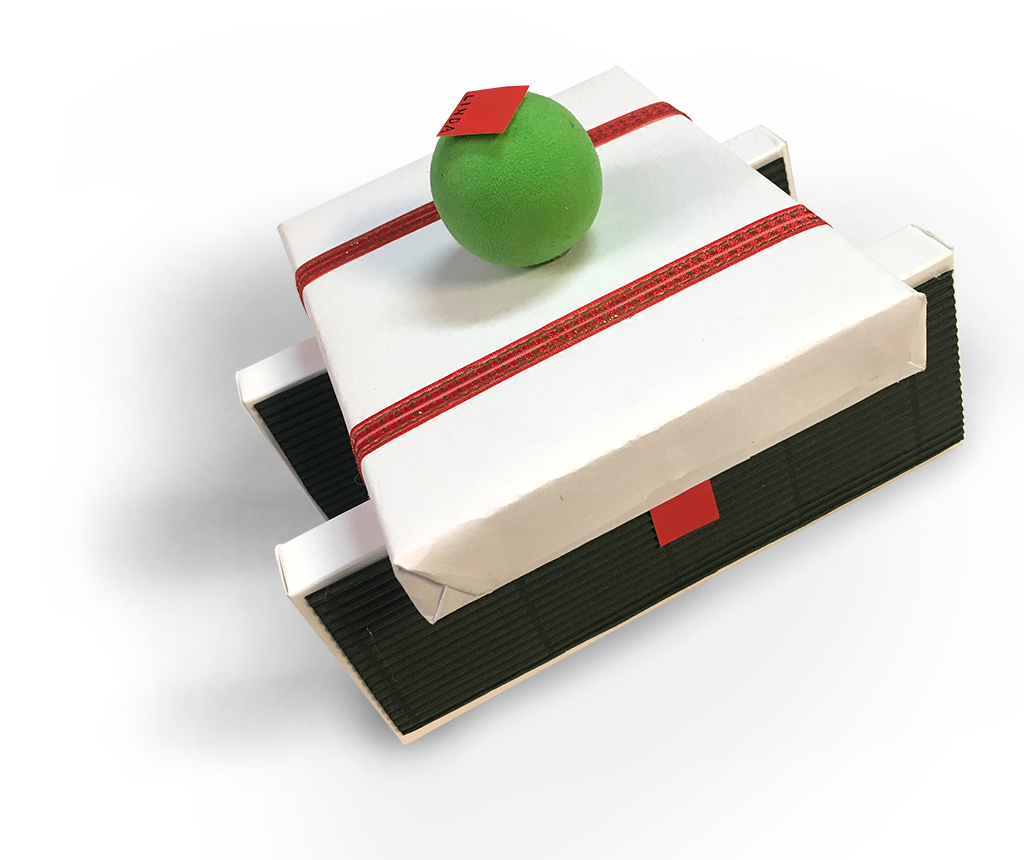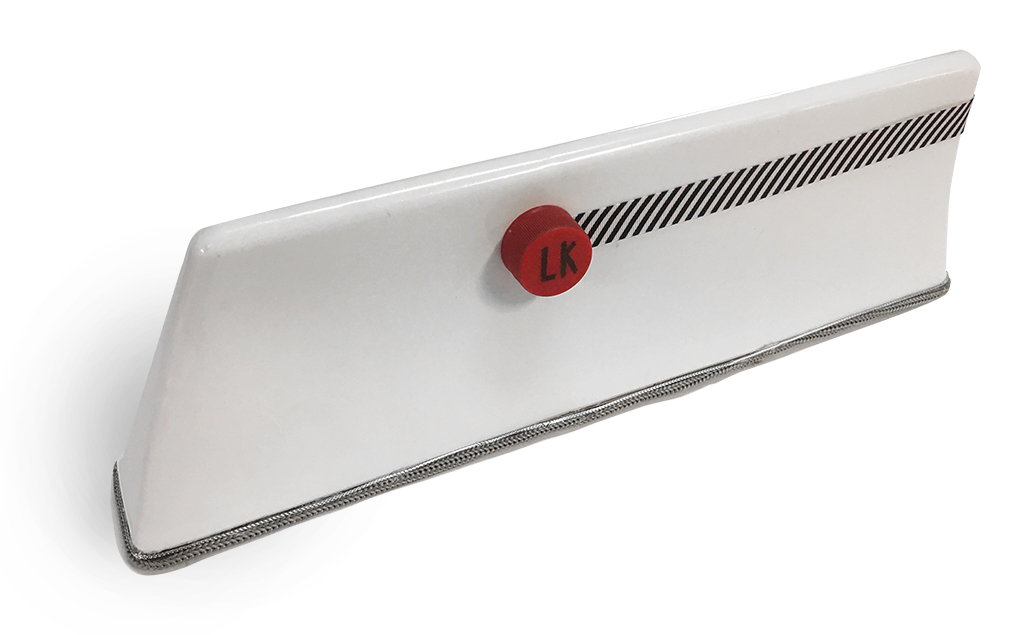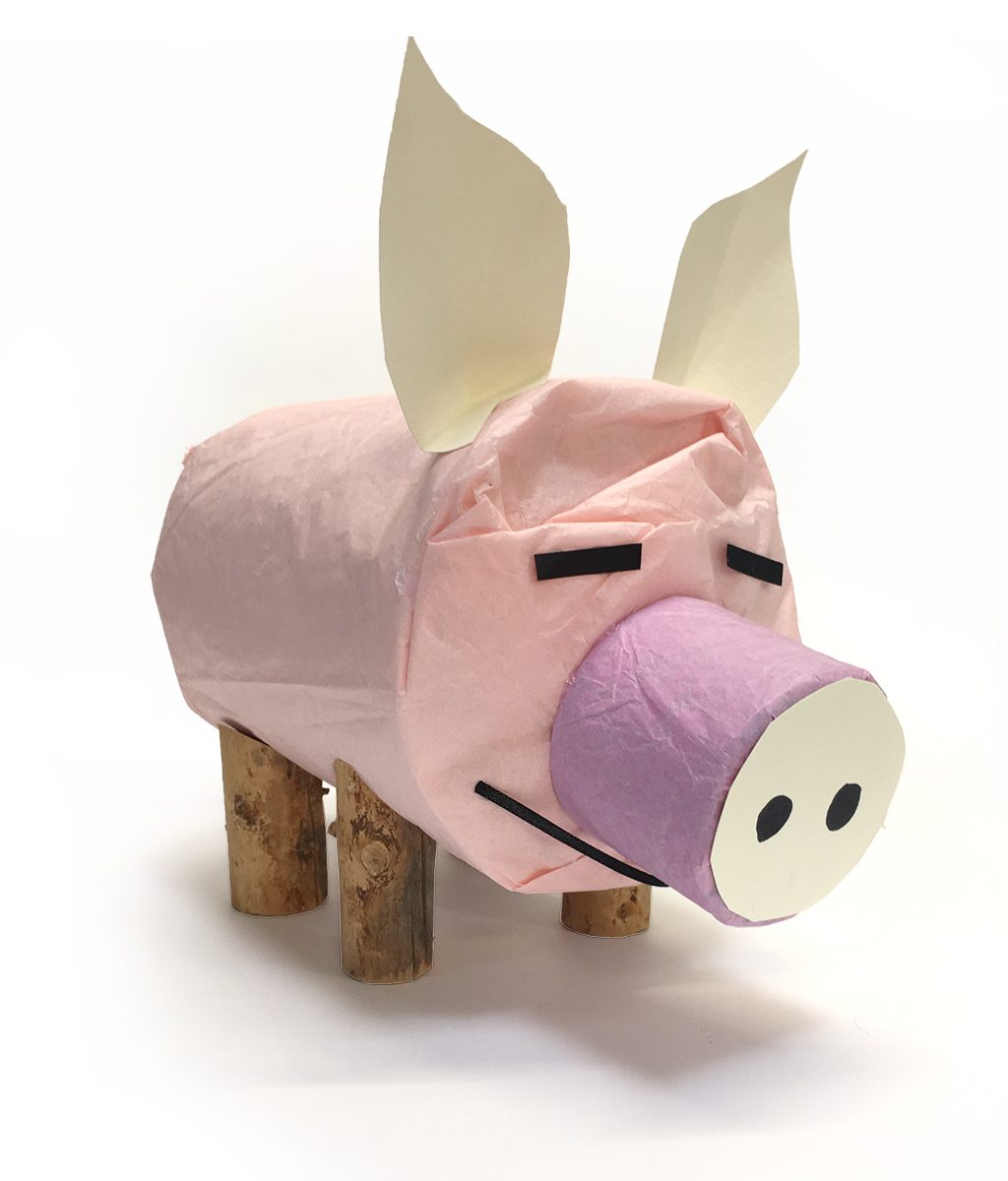Simplicity conjoined with contrast. Two presents conjoined with ribbon. The wrap continues this season’s theme of magazine wrap. This is only my second two-piece wrap. The other was Wrap Synergy in 2010.
2square Mag Collage
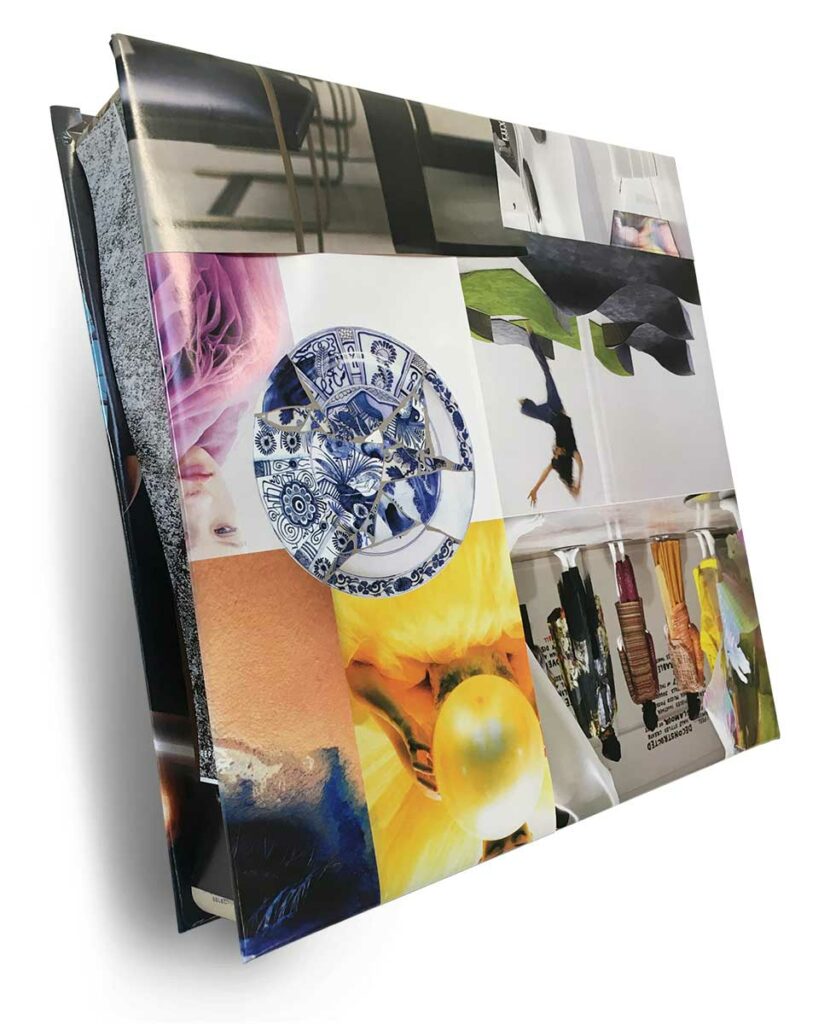
I decided it would be quicker to pack this gift between two squares of corrugated cardboard, than to cut out a custom box. My plan uses corks as pillars to create the space for the gift after creating the two square collages. I covered the two squares with paper from a large design magazine whose ads and special features provided a variety of engaging textures. I used my hot glue sparingly and assembled the collages speedily, wrapping the around the edges of the squares.
I used seven corks to separate the squares. Where the eighth cork would have gone along the middle of one side, I left open space, to ease the retrieval of the gift. To keep the gift from rattling around inside and ripping open the paper walls I planned to glue around the edges of the wrap, I hung the gift inside using three lightly-glue corks, placed strategically in the interior. Then I closed up the wrap with four pieces of cover stock pages, cut to the height of the corks. They are glued to the corner corks. One corner has a “pull open here” sticker placed to guide the recipient in un-wrapping.
It looks like a large picture book, except that there is no spine.
Two Piece with Alphabeads
The two pieces of paper I used came from a large-format magazine with elegant advertisements. The smaller piece with the dot gradation ends in blank white, with an intriguing curve of remnant typography. I labeled the gift with alphabets, whose dimensionality gives the wrap a sculptural tease.
Stripes
This is a classic two-piece wrap. I used a remaining piece of blue Pantone paper on the bottom. Then I reached for a packet of printed American flags that somehow made it into my paper drawer. I chose to use only the stripes, which still left the wrap with a strong hint of flag. I covered the join with a bit of skinny black ribbon. A mini label completes the task.
Mag Wrap
The idea of the “found object” is the essence of this wrap. And like real Duchampian found objects, it can happen quickly. I only used two pieces of paper. One I have since forgotton; it served the parts of the wrap not visible here. The primary piece is a page in a magazine. It’s combination of flatness and dimensionality made it a satisfying piece of wrapping paper.
Shopping Bag with Comb Bow
For the first step wrapping this medium sized gift, I cut down a white shopping bag and wrapped the entire box in it, using hot glue to secure the thick paper of the bag. I put a secondary blue wrap on the bottom, a piece of old Pantone paper. I then took a page from my magazine of the moment, an image with rectangular forms, a person, abstract photo detail and color complementary to the blue. I did not cover up the shopping bag’s branding, because the typography lends the whole composition a poster-like quality. Also the gift’s brand diverges completely from the this bag’s. Wrap Humor. To finish it off I took another magazine scrap and cut slices partway through it. I folded the uncut edge and glued it on top of the wrap. Carefully I shaped the teeth of this comb into gentle curves. The interplay of the rectilinear scrap & scissor-cuts with the curves of the actual spiral imagery in the photo & the shaping of the comb’s teeth adds a bow-like quality and completes the wrap.
Han News
Wrapping with newsprint is a frequent first thought for someone who suddenly decides to wrap without wrapping paper. I chose to give this old method a try using a scrap from a local chinese-language newspaper. The solution to newsprint innovation was actually quite easy to execute. I took one piece of used ribbon and wound it in a spiral around the box. The hardest part was looking through a magazine for just the right page, which would deliver a photographic abstraction up to the task of tri-partite contrast: Han characters, transparent ribbon, and photo complexities, all within my red-blue color world. I cut a wide strip from the ad and folded it along the edges to make a band-wrap ribbon, attached it to the package. Then a took the remaining scrap, folding it to create the same puffy edges; I glued this “bow” onto the wrap.
Three Piece
I thought of the form for this one before anything else. I had saved some Apple cable boxes. They are white and have relatively little type on them. I conceived of them as legs. I covered their largest surfaces with interesting paper. What you see here is dark green, finely-corrugated, specialty stock. The back sides are a medium gray cover stock with lots of visible fiber. I put squares of bright red paper in the center of all four large sides. I then wrapped the gift’s box with white paper and began to play with various arrangements, some fully symmetrical, other cantilevered. I chose the stability of symmetry. I added two pieces of red, textured ribbon, applying them on the gift box to be parallel and aligned to the supporting boxes. I then glued them on, adding an invisible cross-beam of the green corrugated paper between the two boxes to provide stability. I felt the whole thing needed the addition of an non-rhomboid form. I found the pale green ball, and glued it on. Last of all I added the recipient’s name on a small red square.
The Fin
On occasion wrap art will take the shape of animals, buildings, trees or recognizable objects. But almost all wrapping is abstract sculpture, and thus abstraction itself is not innovative. There are, however, times when found materials can take wrapping in a new abstract direction, creating very different feelings. I found a strange plastic object in my alley a number of years ago. It sat in an outdoor shed waiting for purpose. It is about 14 inches long, flat on one side and curved on the other. What is it? Parts divorced from purpose can have immediate mystery. The small, “bottom” side, the plane of attachment, was open. In goes the gift. I then glue on a cardboard closure, including a door for quick access. Two rows of cord, thick and thin hide the seam and start the reference to wrapping tradition. The second reference is ribbon with black and white angled pattern. It starts on the “back” and curves around the end; it breaks with tradition by stopping partway along the facade. That terminus is completed by a red cap which holds the giftee initials. This definitely has undertones of transportation, whether it be streamlined 30’s locomotives or concrete traffic barriers.
Porker Wrap
I went for speed on this one. Chopped down an oatmeal box. Placed the gift in tissue. Glued on a new bottom. Roll-wrapped it in pink tissue using both tape and glue to fix the ends. I left a lot of extra paper on the tail end and twisted it off-center to make a pigtail. I had to work bit of hot glue into the folds of the twisted tissue to make the tail stable and curved. Next I wrapped a deodorant cap with tissue paper and glued it onto the body for the snout, adding the paper fascia with marker nostrils. The eyes are black paper. The mouth is a piece of thin black ribbon, glued to the pink body, and up to the underside of the snout, about an inch away from the body. That means that the smiling mouth is not actually on the pig, but it worked visually. Next I made the legs, using two twigs, each cut at a 45 degree angle to make four legs. I cut little tiny square holes in the pink tissue wrap, which allowed me to glue the legs right to the cardboard of the oatmeal box, assuring a good grip. Lastly, I cut out ears from cover stock, folding the bottom to make an attachment tab; I cut a slit into that tab, which allowed me to bend the ears vertically to get a good simulation of a pigs ear. The pig has been well received.
